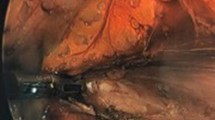Abstract
Patients and methods
Chronic adductor-related groin pain in athletes is debilitating and is often challenging to treat. Little is published on the surgical treatment when conservative measures fail. This single center study reviews the outcomes of 48 patients (68 groins) who underwent percutaneous adductor tenotomy for sports-related chronic groin pain. Questionnaire assessments were made preoperatively and at a minimum follow-up of 25 months.
Results
Mean pre-injury Tegner activity scores of 8.8 reduced to 6.1 post-injury and these improved to 7.7 following surgery (p < 0.001). Sixty percent of patients regained or bettered their pre-injury Tegner activity scores after the adductor surgery; however, mean post-surgical Tegner scores still remained lower than pre-injury scores (p < 0.001). No patient had been able to engage in their chosen sport at their full ability pre-operatively, and 40% had been unable to participate in any sporting activity. The mean return to sports was at 18.5 weeks postoperatively, with 54% returning to their pre-injury activity levels, and only 8% still unable to perform athletic activities at latest follow-up. Seventy-three percent patients rated the outcome of their surgery as excellent or very satisfactory, and only three patients would not have wished to undergo the procedure again if symptoms recurred or developed on the opposite side. No patients reported their outcome as worse. A 78.1% mean improvement in function and an 86.5% mean improvement in pain were reported, and these two measures showed statistically significant correlation (p = 0.01). Groin disability scores improved from a mean of 11.8 to 3.9, post-operatively (p < 0.001). Bruising was seen in 37% of procedures, 3 patients developed a scrotal hematoma and 1 patient had a superficial wound infection. One patient developed recurrent symptoms following re-injury 26 months post-surgery, and fully recovered following a further adductor tenotomy.
Conclusions
Adductor tenotomy provides good symptomatic and functional improvement in chronic adductor-related groin pain refractory to conservative treatment.
Similar content being viewed by others
References
Macintyre J, Johson C, Schroeder EL (2006) Groin pain in athletes. Curr Sports Med Rep 5:293–299
Harmon KG (2007) Evaluation of groin pain in athletes. Curr Sports Med Rep 6:354–361
LeBlanc KE, LeBlanc KA (2003) Groin pain in athletes. Hernia 7:68–71
Lynch SA, Renstrom PAFH (1999) Groin injuries in sport. Sports Med 28(2):137–144
Morelli V, Smith V (2001) Groin injuries in athletes. Am Fam Phys 64(8):1405–1414
Nicholas SJ, Tyler TF (2002) Adductor muscle strains in sport. Sports Med 32(5):339–344
Renstrom P, Peterson L (1980) Groin injuries in athletes. Br J Sports Med 14:30–36
Schilders E, Bismil Q, Robinson P, O’Connor PJ, Gibbon WW, Talbot JC (2007) Adductor-related groin pain in athletes. J Bone Joint Surg Am 89:2173–2178
Holmich P, Uhrskou P, Ulnits L, Kanstrup IL, Nielsen MB, Bjerg AM, Krogsaard K (1999) Effectiveness of active physical training as treatment for long-standing adductor related groin pain in athletes: randomized trial. Lancet 353(9151):439–443
Akermark C, Johansson C (1992) Tenotomy of the adductor longus tendon in the treatment of chronic groin pain in athletes. Am J Sports Med 20:640–643
Martens MA, Hansen L, Mulier JC (1987) Adductor tendinitis and musculus rectus abdominis tendopathy. Am J Sports Med 15(4):353–356
Verrall GM, Slavotinek JP, Barnes PG, Fon GT (2005) Description of pain provocation tests used for the diagnosis of sports-related chronic groin pain: relationship of tests to defined clinical (pain and tenderness) and MRI (pubic bone marrow oedema) criteria. Scand J Med Sci Sports 15:36–42
Dawson J, Fitzpatrick R, Carr A, Murray D (1996) Questionnaire on the perceptions of patients about total hip replacement. J Bone Joint Surg [Br] 78(2):185–190
Meyers WC, Lanfranco A, Castellanos A (2002) Surgical management of chronic lower abdominal and groin pain in high performance athletes. Curr Sports Med Rep 1:301–305
Van der Donckt K, Steenbrugge F, Van den Abbeele K, Verdonk R, Verhelst M (2003) Bassini’s hernia repair and adductor longus tenotomy in the treatment of chronic groin pain in athletes. Acta Orthop Belg 69:36–40
Acknowledgments
We would like to thank Professor Nikola Kocev PhD, Institute for Medical Statistics and Computing, Belgrade University, Serbia, for his assistance with the statistical analyses.
Conflict of interest statement
No competing interest or funding declared.
Author information
Authors and Affiliations
Corresponding author
Rights and permissions
About this article
Cite this article
Atkinson, H.D.E., Johal, P., Falworth, M.S. et al. Adductor tenotomy: its role in the management of sports-related chronic groin pain. Arch Orthop Trauma Surg 130, 965–970 (2010). https://doi.org/10.1007/s00402-009-1032-4
Received:
Published:
Issue Date:
DOI: https://doi.org/10.1007/s00402-009-1032-4




